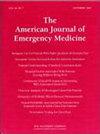Colubrid snake envenomation: Erythrolamprus bizona “false coral” snakebite - clinical aspects and importance of identifying mimics
IF 2.7
3区 医学
Q1 EMERGENCY MEDICINE
引用次数: 0
Abstract
Colubrids represent a diverse group of snakes historically regarded as harmless. With over 300 genera, the Colubridae family is the largest, encompassing approximately two-thirds of extant snake species. We describe a case of an 18-year-old male who suffered a colubrid snakebite from Erythrolamprus bizona, commonly known as the double-stranded coral snake mimic or false coral snake, which he misidentified as Lampropeltis sp., a fangless colubrid snake. Patient experienced localized erythema and edema, which later spread to the entire left hand along with moderate pain. Laboratory tests revealed leukocytosis and elevated creatine kinase. Symptoms resolved one week later. This case highlights the public health significance of ophidian accidents due to apparently “non-venomous snakes” or low-risk snakes such as the opisthoglyphous colubrid E. bizona. It also underscores the need to correctly identify and differentiate these snakes from other harmless colubrids, particularly double-stranded coral snake mimics in areas of geographic overlap and avoid their manipulation if uncertain of their taxonomic status.
眼镜蛇咬伤:Erythrolamprus bizona "假珊瑚 "蛇咬伤--临床方面和识别拟态的重要性。
琉璃蛇是一个种类繁多的蛇类群体,历来被认为是无害的。胭脂鱼科有 300 多个属,是最大的蛇类科,约占现存蛇类物种的三分之二。我们描述了一例 18 岁男性被 Erythrolamprus bizona(俗称双股珊瑚蛇拟态或假珊瑚蛇)蛇咬伤的病例。患者局部出现红斑和水肿,后来扩散到整个左手,并伴有中度疼痛。实验室检查显示白细胞增多,肌酸激酶升高。一周后症状缓解。该病例突出表明,由表面上 "无毒蛇 "或低风险蛇类(如 opisthoglyphous colubrid E. bizona)引起的食人事故具有重要的公共卫生意义。它还强调了正确识别和区分这些蛇与其他无害疣蛇的必要性,特别是在地理重叠地区的双股珊瑚蛇模仿品,如果不确定它们的分类地位,应避免操纵它们。
本文章由计算机程序翻译,如有差异,请以英文原文为准。
求助全文
约1分钟内获得全文
求助全文
来源期刊
CiteScore
6.00
自引率
5.60%
发文量
730
审稿时长
42 days
期刊介绍:
A distinctive blend of practicality and scholarliness makes the American Journal of Emergency Medicine a key source for information on emergency medical care. Covering all activities concerned with emergency medicine, it is the journal to turn to for information to help increase the ability to understand, recognize and treat emergency conditions. Issues contain clinical articles, case reports, review articles, editorials, international notes, book reviews and more.

 求助内容:
求助内容: 应助结果提醒方式:
应助结果提醒方式:


